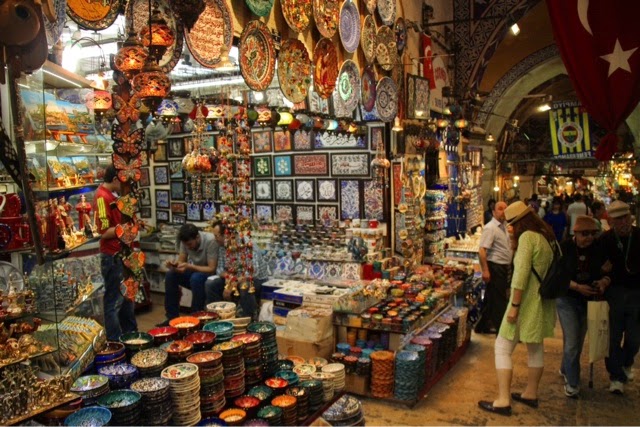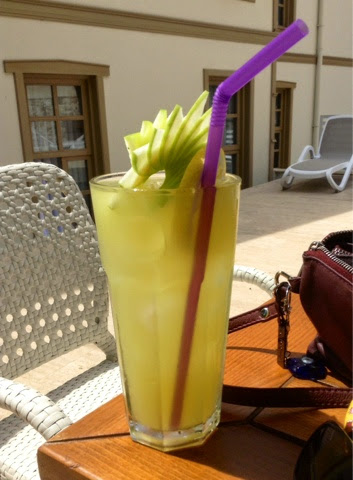Sometimes, despite what the philosophers say, it actually IS about the destination, not the journey. We were dutifully collected at the appointed time from our hotel in Kas by our driver who delivered us to Antalya without event, about 2.5 hours later. He didn't speak to us, which has happened with other drivers and always leaves us wondering whether it's because he doesn't speak English or he's sullen or he actually does speak English but thinks it's not his job to chat to us. At the end of the day, the most important thing is that they drive safely with their attention to the road ahead, so that's all ok.
The drive to Antalya was very pretty, with the mountains making a wonderful backdrop to the magnificent coastal views. I don't think I've ever been to a city where you can look out to the sea and instead of seeing the endless horizon, you see mountains.
Antalya is quite a big city, with a population of about two million. It's divided into the Old City and the New City, with each being completely different. Our driver had a real problem finding our hotel in the Old City - he stopped and asked directions about six or seven times. We were relaxed about it, because (a) we could sit back in airconditioned comfort knowing we'd get there eventually, (b) we weren't the ones driving and navigating and (c) we weren't lugging suitcases up and down cobblestoned streets in 35 degrees hoping against hope that our hotel would suddenly appear around the next corner. Turns out that there are two hotels with almost identical names, so we went around in circles and up blind alleys a few times, despite protracted animated conversations (with hand gestures) between our driver and several locals. Antalya is also a very bustling large city, quite a foreign concept to our driver from Kas, who was out of his depth and probably struggling to stay calm. No-one was more relieved than he was, to leave us at the front door of our hotel - he almost burned rubber reversing back out of the laneway on his way back to the quiet life in Kas.
The old part of Antalya is a maze of hilly narrow thoroughfares lined with carpet (and other) shops, all of which wind down to a very picturesque harbour full of fake pirate ships - we think these relate to olden times off the coast of Turkey, when the waters were a dangerous place to travel, due to roaming pirates looting and plundering. The pirate ships in Antalya harbour are decked out like something from the Caribbean movies and take tourists on journeys around the port area.
We've enjoyed the past few days here and have found people to be very friendly. Yesterday we went with the hotel's driver on a tour of the local waterfalls, both of which were spectacular. Along the way, he chatted happily about Antalya and was very interested to hear about Australia. He was horrified about the price of things in Oz (so are we....).
The Upper Duden waterfall is 15m high and 20m wide and set in a pretty valley. A natural cave has formed behind the falls and it is possible to wander through the cave and watch the cascades from behind. There are restaurants, boardwalks and picnic tables in the gardens immediately surrounding the falls to help make the most of this gorgeous scenic spot.
The Kursunlu waterfalls are set in a serene location amongst forested surrounds. It felt very relaxing to be so close to a big city, yet so far from the hubbub of people and traffic.
Returning to our hotel, it was spa time downstairs. For me this was an especially wonderful experience, as my attendant masseuse was a 6'2" gorgeous dark-haired, dark-eyed young man from the Turkish version of Central Casting, wearing only a towel around his waist as he lathered me up, scrubbed me down, massaged oil into my aching bits and released me back to the world after two hours of his undivided attention. D2 decided to spend the time reading and napping in the hotel room, so we'll never know who would have looked after him, in the spa.
Today we went on a trip to the local market; we do love markets, and it's hard not to feel a bit jealous about the quantity and quality of the fresh fruit and veg available to the locals at prices a fraction of what they are in Oz. Sometimes we have to question if we do live in the lucky country.
We've spent quite a lot of our time in Antalya lying on sun lounges by the hotel pool, reading and sipping drinks with little umbrellas or fancy garnishes in them.
The weather has been perfect, as it pretty much has been since we arrived in Turkey, so we've been very lucky. Tomorrow morning we will be collected from the hotel by another driver and taken to the airport for our trip to Ankara and our next driver who will take us to Cappadocia.
This is where we didn't get anything tattooed or pierced.
D1




























































